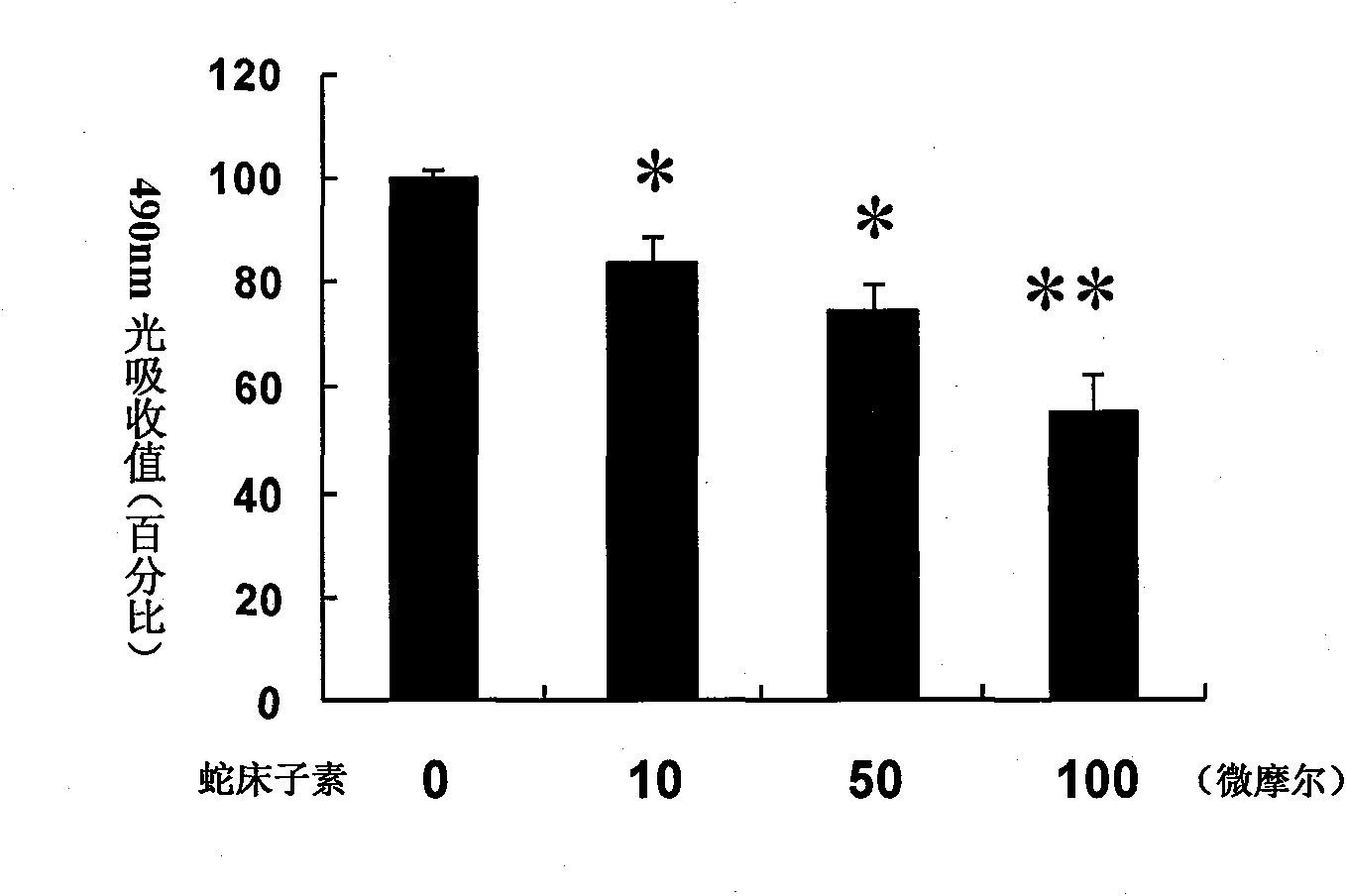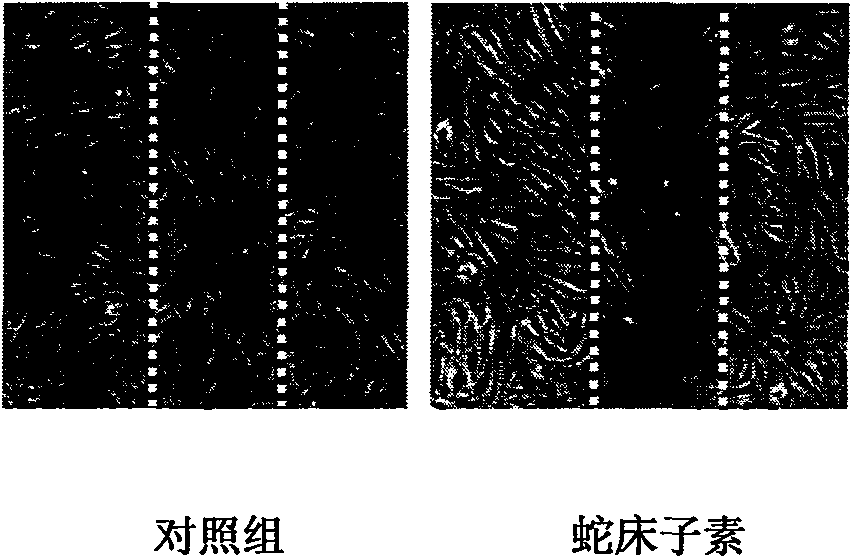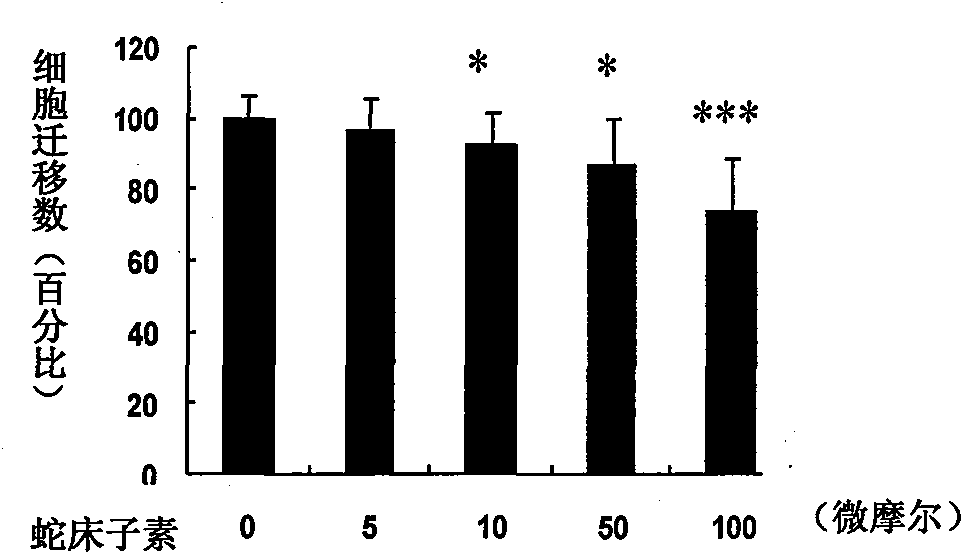Application of osthole in preparing anti-angiogenic drugs
A technology of angiogenesis and osthole, which is applied in drug combinations, antipyretics, antineoplastics, etc.
- Summary
- Abstract
- Description
- Claims
- Application Information
AI Technical Summary
Problems solved by technology
Method used
Image
Examples
experiment example 1
[0020] Experimental example 1: In vitro proliferation experiment of osthole inhibiting human umbilical vein endothelial cells
[0021] Purpose and principle: MTS assay was used in endothelial cell proliferation assay. The MTS assay is an assay that uses a colorimetric method to indirectly measure the number of viable cells. In living cells, NADPH dehydrogenase in mitochondria converts MTS tetrazolium salt compound into a colored substance - formazan, which is soluble in cell culture fluid, and its color depth is highly correlated with the number of living cells of the cell line within a certain range. The effect of drugs on cell proliferation can be evaluated by this method.
[0022] Method: Inoculate human umbilical vein endothelial cells into 96-well plates (5000 cells / well), add medium containing different concentrations of osthole for 48-72 hours, then add chromogenic reagent and incubate for 1-4 hours. Read the absorbance of each well at 490 nm with a microplate reader....
Embodiment 2
[0024] Embodiment 2: Osthole inhibits human umbilical vein endothelial cell migration experiment in vitro
[0025] Purpose and principle: Cell migration test is also called in vitro scratch test. In this experiment, scratches were made on the overgrown monolayer endothelial cells in the culture plate, observed under a microscope, and the number of newly immigrated endothelial cells at the scratches was recorded to evaluate the effect of drugs on the migration ability of endothelial cells.
[0026] Method: Inoculate the cells in a 6-well plate, and when the cells grow to about 90%, use a pipette tip to make a cross scratch in each well. Wash the scratched cells with PBS, add the medium containing different concentrations of drugs and VEGF, at 37 ° C, 5% CO 2 Cultivate in the incubator until the VEGF group is overgrown
[0027] Results and evaluation: The experimental results are as follows: Figure 2a , Figure 2b As shown, the photographed statistics were observed under a ...
Embodiment 3
[0028] Example 3: Osthole Inhibits Human Umbilical Vein Endothelial Cell Migration Experiment in Boyden Chamber in Vitro
[0029] Purpose and principle: The in vitro Boyden chamber migration experiment of human umbilical vein endothelial cells adopts the Boyden culture chamber of Millipore Company. Under the induction of growth factors, the cells can pass through the 8-micron membrane of the chamber. This experiment can detect the effect of drugs on the endothelial cell membrane penetration ability. influences.
[0030] Method: Put the chamber into a 24-well cell culture plate, add gelatin and incubate for 30 minutes, discard the gelatin after 30 minutes, and wash three times with PBS. Add endothelial cell medium containing VEGF outside the small chamber, insert a certain number of cells into the small chamber, and then add different concentrations of osthole drugs, at 37 ° C, 5% CO 2 Incubate for four hours in the incubator.
[0031] Results and evaluation: After four hours...
PUM
 Login to View More
Login to View More Abstract
Description
Claims
Application Information
 Login to View More
Login to View More - R&D
- Intellectual Property
- Life Sciences
- Materials
- Tech Scout
- Unparalleled Data Quality
- Higher Quality Content
- 60% Fewer Hallucinations
Browse by: Latest US Patents, China's latest patents, Technical Efficacy Thesaurus, Application Domain, Technology Topic, Popular Technical Reports.
© 2025 PatSnap. All rights reserved.Legal|Privacy policy|Modern Slavery Act Transparency Statement|Sitemap|About US| Contact US: help@patsnap.com



